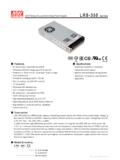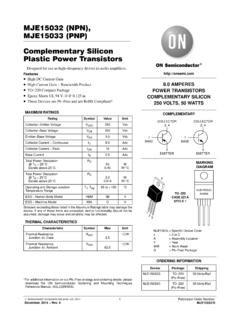Transcription of Guide to Fuse Selection - Schurter
1 Selection Guide1 Guide to fuse Selection Guide2 Purpose of Fuses>Circuit protection is critical, and in many cases required, in electrical and electronic products.>Fuses are an inexpensive and effective way to protect your device from damage due to overcurrent conditions.>Fuses can prevent safety hazards to the end user such as fire and catastrophic failure of the product.>Fuses help design engineers comply with regulatory agencies such as UL and Selection Guide3 Characteristics of FusesSchurter offers a wide variety of fuses to meet any application:>Package type (SMD, thru hole, cartridge)>Current and voltage ratings (AC and DC power)>Trip characteristics (quick-acting or time-lag)>Breaking capacity ratings>Approvals (UL, CSA, ENEC, CCC) Selection Guide4 Size and Mounting>Schurteroffers 0402, 0603, 1206 SMD fuses>Thru hole microfuses>Cartridge fuses 5x20mm, and >Cartridge fuses can be mounted in fuseholders, fuseblocksor fuseclips>We also offer pigtails for a low cost thru hole Selection Guide5>The rated current of the fuse is either designed according to IEC characteristic or UL characteristic.
2 >A fuse , which is designed according to a IEC standard, can continuously operate at 100%of rated current of the fuse .>A fuse , which is designed according to a UL standard, can continuously operate at 75%of rated current of the fuse .>The fuse current rating should be based on the operating current in the Current Selection Guide6>Breaking capacity is the maximum short circuit current a fuse can safely blow without a catastrophic failure such as a fire, breakage or explosion.>Low and high breaking capacity ratings typically range from 35A up to 10kA.>The short circuit condition in the final product determines what fuse breaking capacity is needed.
3 >Our UMT is a compact SMD fuse with a high breaking capacity of Selection Guide7>Fuses are either quick-acting or time-lag.>Time-lag fuses trip at a slower rate at high CharacteristicQuick-actingTime-lagLoad typeResistiveCapacitiveInrush Current WithstandLowHigh(10 times rated current)Applications Data/signallines Electronic components Power supplies Motors Circuitswith capacitorsAdvantage Avoiddamage downstream due to inrush Avoid nuisance tripping during Selection Guide8 Temperature derating > fuse current ratings are measured at 23degC.>Fuses are temperature dependant so higher the ambient temperature the quicker the fuse will blow.
4 >Ambient temperature of the application must be considered when choosing the current rating of the Selection Guide9 Temperature DeratingExample UMT 250 SMD FuseApplication example: fuse type:UMT 250 Operating A @ 60 COperating voltage:230 VACA mbient temperature:< 60 CCalculation of rated current of the fuse with the derating curve:A ingN Choice: UMT 250, A(1 A @ 60 C) derating -curve UMT 250 (see data sheet) Selection Guide10 Heat Issues>Heat dissipated from fuses can affect other components in close proximity and vice versa.>Sufficient airflow and ventilation should be considered when designing fuses in the application.> Schurter fuseholder and fused module datasheets have power acceptance ratings which show how much heat dissipation it can withstand safely.
5 >If a fuse dissipates more heat than the fuseholder can withstand, the fuseholder can degrade such as melt or burn. Fused moduleFuse and Selection Guide11 Power(heat)Dissipation>Fuses dissipate heat during normal operation and this can increase as ambient temperature increases.>Time-lag fuses generally have lower power dissipation values than quick-acting fuses because they have a thicker fuse wire diameter.>Here s our FST spec sheet where we publish the typical Power Dissipation value.>When choosing a fuseholder or fused module, the power acceptance value should exceed the fuse power dissipation Selection Guide12 Inrush Current>Many applications will have inrush or peak currents at start-up and sometimes during normal operation.
6 >The inrush current in the application should be measured and used to calculate the proper fuse I2tvalue. >I2tis the amount of heat energy, in terms of current and time, required to melt the fuse Selection Guide13 WaveformsInrush Current PeakProcedure>Step 1: Selection of the appropriate waveform of the inrush used curveWave shapes FormulasWave shapes Selection Guide14I2t CalculationInrush Current Peak>Step 2: Calculation of the I2t-value of the applicationApplication example:Inrush current peak: Ip= 13 A, = sType of waveform: Typical discharge curveCalculation of the I2t-valuesA *A) (1321 *I21tI222pnApplicat io2 After 5 , the inrush current has reached operating Selection Guide15 Pulse Factor DeratingInrush Current Peak >Continuous exposure to pulses of high current could prematurely age the fuse .
7 >The number of pulses the fuse would be exposed to in the application should also be considered when choosing a plating ofnew fuse wireTin plating ofaged fuse wireWireTin Selection Guide16 Pulse Factor DeratingInrush Current Peak>Step 3: Determine the minimum value of the I2t-value of the example:Total number of pulses in life cycle: 10,000 UMT 250 = time-lag fusesCalculation of time-lag Tfuses(Calculation of quick-acting Ffuses)sA io2 Fuse_F_min2 sA io2 Fuse_T _min2 Pulse- derating Selection Guide17 Selecting a fuse Part Number>Step 4: Selection of the correct fuse rating and part number from Schurter s product line.>Typical I2t-values at 10*Infor Schurter 1 A time-lag T fuses>MST250 (12 A2s), UMT 250 ( A2s), FST 5x20 ( A2s), SPT 5x20( A2s)>(Typical I2t-values at 10*Infor Schurter 1 A quick-acting F fuses)>OMF 250 ( A2s), MSF 250 ( A2s), FSF5x20 ( A2s), SP 5x20 ( A2s)Choice: UMT 250, 1 A( A2s > A2s) Selection Guide18 fuse Selection >Normal Operating Mode>Inrush Current PeakChoice: UMT 250, A(1 A @ 60 C)> The higher value determines the Selection of the rated current of the fuse .
8 > The normal operating mode current exceedsthat of the inrush current , the A fuseis the recommended fuse : UMT 250, 1 A( A2s > A2s) Selection Guide19 WebsiteSelection, Datasheets, Approval Documents, CAD Selection Guide20 Thank youGuide to fuse Selectio





